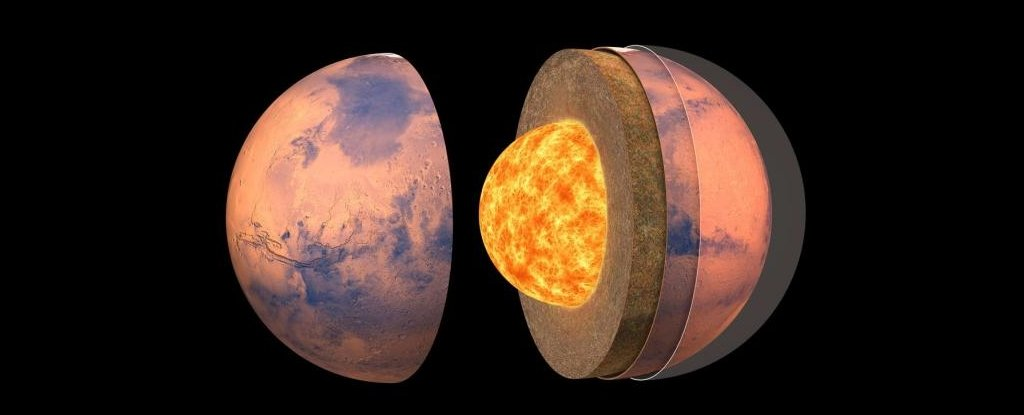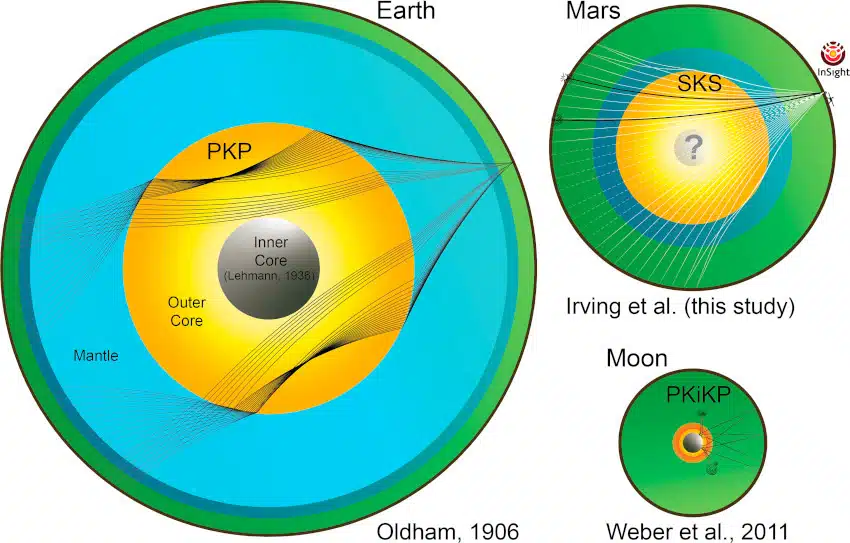The nature of Mars' core revealed by seismic waves passing through it

From November 2018 to December 2022, NASA's InSight mission explored the internal structure of Mars. The analysis of the seismic waves recorded by the probe made it possible to determine the thickness and the composition of the various internal layers, as well as the thermal state of the planet. For the first time, scientists have identified seismic waves propagating through the core: this data not only makes it possible to characterize the heart of the planet, but also to better understand the process of formation of telluric planets.
The InSight mission ( Interior exploration using Seismic Investigations, Geodesy and Heat Transport ) landed in the Elysium Planitia region on November 26, 2018. To carry out its mission, the lander was equipped with a very broadband seismometer ( SEIS) and a heat flux sensor (HP3). The data collected over four years made it possible to characterize the Martian crust and mantle. Tidal forces exerted by Phobos — one of Mars' two small moons — have also suggested that the Martian core is mostly, if not entirely, liquid.

The elastic properties and the composition of the core were estimated via theoretical models, but remained to be confirmed. An international research team, which included seismologists from the University of Maryland (UMD), was able to use seismic data from Mars for the first time to directly determine the properties of the core: the latter consists of an iron alloy completely liquid, with high percentages of sulfur and oxygen. These findings also highlight why Mars is so different from Earth.
A liquid core, particularly rich in light elements
“ In 1906, scientists first discovered the Earth's core by observing how seismic waves from earthquakes were affected as they travel through it. More than a hundred years later, we are applying our knowledge of seismic waves to Mars ,” said Vedran Lekic , associate professor of geology at UMD and co-author of the study reporting the discovery. Although the InSight mission ended a few months ago, scientists continue to carefully examine the data collected.
To date, only two seismic events — designated S0976a and S1000a — have been identified as being located on the hemisphere of Mars opposite the InSight lander. These events were located using phases identified as PP and SS waves, which descend to a depth of nearly 1200 km in the Martian mantle and are reflected on the surface of Mars halfway through their trajectory, explain the researchers in their article.

Location of the two events, S0976a (red circle) and S1000a (blue star), and of the InSight seismometer (orange triangle). The dotted lines show the trajectory of SKS waves in the mantle, and the solid lines describe the part of the trajectory in the core. The trajectories of the SKS and PP seismic phases are represented in the same colors as the events. SKS runs through the core; PP remains in the coat.
By comparing the travel time of waves passing through the core (denoted SKS) to that of waves remaining in the mantle (PP and SS waves), and combining this information with other seismic and geophysical measurements, the team was able to estimate the density and compressibility of the material traversed. The results indicate that Mars most likely has an entirely liquid core — unlike Earth, which combines a liquid outer core and a solid inner core (also called a "seed"). Its radius is between 1780 and 1810 kilometers.
The researchers were also able to learn a bit more about the chemical makeup of the core: " Our results are consistent with a sulfur-rich core, with smaller fractions of oxygen, carbon, and hydrogen ," they note, adding that 20 to 22% of the weight of the core would be made up of these light elements. This constitutes another major difference with the Earth, whose core is composed mainly of iron and nickel, and has a much lower proportion of light elements.
Geophysical differences explaining the absence of life
The Martian core therefore appears much less dense and more compressible than that of Earth, which suggests different formation conditions for these two planets. The researchers report a density of 6.2 to 6.3 g/cm 3 (vs. 10 g/cm 3 for the outer core and 13 g/cm 3 for the inner core of the Earth). This difference could partly explain why life appeared on Earth and not on Mars. “ The end result of the processes of formation and evolution can be the creation or absence of conditions conducive to life ,” emphasizes Nicholas Schmerr, associate professor of geology at UMD and co-author of the article.

Diagram showing the paths of the waves crossing the core of the three planetary bodies explored seismically: the Earth, Mars and the Moon. The colors correspond to different dominant minerals and phases: olivine (in green), post-olivine phase transition (in dark blue), bridgmanite (in light blue), liquid metallic core (in shades of yellow), inner core (in gray ).
Remember that it is in the outer core that the Earth's magnetic field is generated, via a self-sustaining dynamo mechanism (which is based on the convection movements of the metal alloys in the liquid part of the core). This magnetic field played an essential role in the appearance of life, by protecting the surface from solar winds.
Mars does not have a magnetic field today, but the traces of magnetism that remain in the Martian crust indicate that one probably once existed. Lekic and Schmerr note that this could mean that Mars gradually evolved from a potentially habitable environment to a much more hostile one. Conditions within the planet may have played a key role in this evolution. It remains to clarify the processes responsible for this major change.
In the meantime, these results have made it possible to confirm the accuracy of the modeling carried out in order to have a first glimpse of the internal structures of Mars; these models can therefore be applied to other planets. Similarly, for the authors of the study, this type of research paves the way for future expeditions focused on the geophysics of other celestial bodies, including Venus and Mercury.
Source : websites

